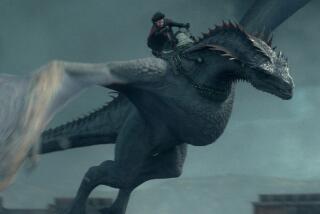Camera, legal action!
- Share via
It was supposed to be a win-win, with Guam gaining a toehold in the film industry and two Hollywood moviemakers getting the island government’s backing for their new kung fu franchise.
“Max Havoc: Curse of the Dragon” was the first of at least two action flicks that producer John F.S. Laing and director Albert Pyun planned to shoot on Guam as part of an unusual deal with the U.S. territory’s economic development agency.
But instead of generating jobs and a box-office bonanza, “Max Havoc” triggered the biggest battle on the Pacific island since the Son of Godzilla tangled with giant insects in 1967.
Guam officials contend that Laing snookered them into putting up $800,000 to guarantee a bank loan on which he later defaulted. Laing counters that they broke their promises of financial support and caused his company to lose $1.5 million.
Territorial Sen. Ben Pangelinan splits the blame, accusing the filmmakers of peddling “the glitz of Hollywood” to star-struck officials who were all too eager to buy it.
“If somebody on Guam wanted to meet Carmen Electra, there are a lot cheaper ways than backing a film in which she had a three-minute part,” said Pangelinan, a lonely voice of dissent when the plan was hatched three years ago.
In the resulting 90 minutes of cinematic chop sockey, Swiss-born Mickey Hardt stars as a champion kickboxer-turned-sports-photographer drawn into a web of intrigue on Guam. The plot revolves around women in bikinis, clashes with Japanese assassins, a coveted jade dragon filled with cremated remains and a sinister “grand master” played by David Carradine. Electra has a blink-and-you’ll-miss-it cameo as a beach vendor.
“The whole thing was just bad all the way around,” said Ralph Coon, a Pasadena lighting technician who worked on the movie. “This thing was really destined to wind up in the cutout bin of some truck stop on the way to Barstow.”
What sets “Max Havoc” apart from other low-budget, straight-to-video gobblers is how and why it came to be filmed on Guam, a remote locale 1,500 miles south of Japan and 6,000 miles from Hollywood -- with no moviemaking infrastructure.
Although the island has been the backdrop for “Son of Godzilla,” the 1962 war movie “No Man Is an Island” and some Japanese commercials, “Max Havoc” marked Guam’s most concerted effort to fetch Hollywood dollars.
In all, 30 states and various countries try to attract filmmakers with tax breaks, free office space, police services and other incentives, said California Film Commission director Amy Lemisch. But she knew of none that had plunked down cash to guarantee a third-party loan, putting taxpayers’ money on the line if a producer defaulted.
“That, like, blows my mind,” she said.
In dueling lawsuits filed in the Superior Courts of Guam and Los Angeles County, the island government seeks to recoup its money from Laing. He denies owing it and wants $2 million in damages.
Their now-soured relationship began in October 2003, when Pyun contacted the Guam Economic Development Administration about shooting the movie on the island after terrorist bombings scuttled his plans for Indonesia, e-mail records show.
The director made his debut in 1982 with the generally wellreceived “The Sword and the Sorcerer.” Since then, it’s been mostly B titles such as “Bloodmatch” and “Brain Smasher: A Love Story,” prompting one online reviewer to dub him “King of the Hacks.”
In a November 2003 letter, Pyun told a Guam official that he and Laing’s Los Angeles-based Rigel USA Inc. were interested in starting a feature-film company on the island.
“These motion pictures will be repeatedly broadcast in major markets like Japan, Korea, USA and Europe for many years to come, giving Guam and its tourism industry unprecedented and ongoing exposure and promotion,” he wrote, later predicting as many as six films a year.
Those rosy projections were no more than “a bill of goods” sold to Guam officials, said Matthew Borden, one of the government’s lawyers.
Sen. Pangelinan agrees, accusing Pyun and Laing of dealing in bad faith with then-economic development chief Gerry Perez, Gov. Felix Camacho and other officials.
“They were not able to distinguish a real deal maker from pie-in-the-sky, promise-’em-the-moon deal makers who promised to bring things to Guam and in the end took things from Guam,” Pangelinan said.
Robert Underwood, who lost a bid to unseat Camacho last year, said dropping $800,000 wasn’t the worst of it.
“The money is not as big as the fact that it symbolizes the ineptness and the naivete of some of the people in the government of Guam,” said Underwood, who formerly represented Guam as a nonvoting delegate to the U.S. Congress. “It’s more an embarrassment than anything else.”
Camacho and Perez declined to comment.
Laing, a former head of Orion Pictures’ international television division, insists that he was the prey, not the predator. When he first visited the island in late 2003, he said, Guam officials treated him like a foreign dignitary and eventually pledged $3 million in loans and other incentives.
“I had no reason to go and sell a bill of goods to Guam,” Laing said. “Basically, they sold me a bill of goods. They said, ‘We can do all these things, just come.’ ”
Guam officials deny making any such promises, and Laing acknowledges that he got nothing in writing.
Ultimately, Guam agreed to put up $800,000 in cash as collateral to secure a $1-million loan from Comerica Bank to Laing’s newly formed Guam Motion Pictures Co. In return, Laing agreed to repay the $800,000 if his company defaulted.
In March 2004, production began with a crew hastily rounded up mostly from Los Angeles, along with a few locals.
“The pay wasn’t any good, but I wasn’t working that particular three weeks, so I went,” said Coon, the assistant lighting director, who made $150 a day but had to wait six months for all of it.
The crew worked 14 to 16 often chaotic hours a day, he said, mostly “shooting people running up and down the hallways” of the luxury-class Outrigger Guam Resort hotel.
“We’d shoot one scene on the fourth floor, then move all our lighting and camera gear to the 11th floor for a scene there, and then move all our gear back to the fourth floor for another scene there,” he said.
Electra generated a buzz on the island, Coon said, despite her fleeting role and her repeated mispronunciation of “Gluam” while filming a public service spot. She also brought some star power to a gala dinner with island leaders.
“The governor is standing next to me and we’re behind Carmen Electra and he’s looking down her bustier and he says to me, ‘Wow, look at that. That’s Hollywood!’ ” Laing said.
Guam businesses, eager to encourage the production, contributed about $1 million in goods and services, including cellphones and food for the cast and crew.
Primo Surf owner Linda Yeomans said she chipped in about $8,000 worth of clothing and accessories and paid her own expenses for related buying trips to Australia and Bali.
“I didn’t see any return out of it,” she said. “I just wrote it off as a loss.”
Laing calls the Guam experience “the most extraordinary debacle of my life” but lays much of the blame on Pyun. The director was replaced for a 10-day reshoot in Los Angeles, when Carradine and actor Richard Roundtree of “Shaft” fame were added to prop up the movie.
“Someone, usually the director, is always blamed when a project doesn’t realize everyone’s hopes,” Pyun said in an e-mail, citing problems with funding and equipment. “The film was shot on a shoestring and a prayer. I did the best I could.”
The producers struggled to find distributors for the film, for theaters or television, according to an e-mail Laing sent to Guam officials in February 2005. His company defaulted on the loan in June 2006 and the bank foreclosed on it, seizing Guam’s $800,000 and the film.
In his lawsuit, filed in Los Angeles, Laing contends that his agreement to guarantee the collateral should be voided because he signed it under “duress and menace” by Guam officials.
“I would say that, given the circumstances, we did what can only be described as an extremely noble and honorable job in delivering the best we could,” he said.
Coon is among those who have a different view.
“I’ll give you $20 if you can watch 20 minutes,” he said.
--
(BEGIN TEXT OF INFOBOX)
Choppy waters
The movie: “Max Havoc: Curse of the Dragon”
The plot: After killing an opponent in a fight, a kickboxing champion quits to roam the world as a sports photographer. While on assignment in Guam, he comes to the aid of a hot, young artifacts dealer targeted by the deadly Black Dragons, assassins who will stop at nothing to reclaim a sacred jade dragon burial urn in her possession. Oh, and he also saves the art dealer’s fetching young sister from drowning.
The cast: Mickey Hardt, Joanna Krupa, Nikki Ziering,
Carmen Electra, David Carradine and Richard Roundtree
--
Source: Times research
More to Read
Only good movies
Get the Indie Focus newsletter, Mark Olsen's weekly guide to the world of cinema.
You may occasionally receive promotional content from the Los Angeles Times.











